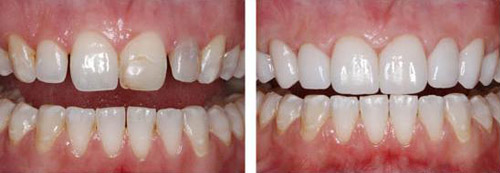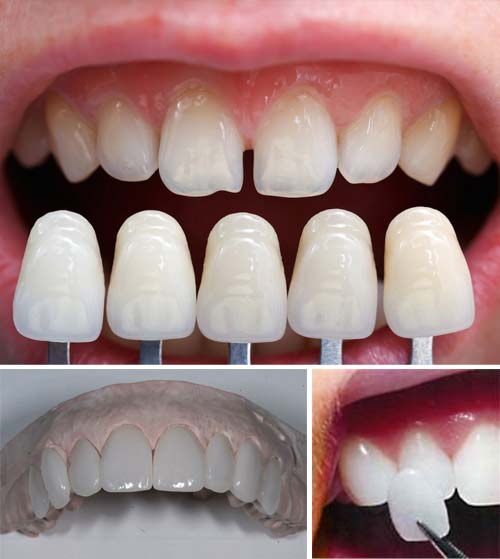In case of a dental emergency that requires same day bookings, please call 08 9276 1540

VENEERS
Porcelain Veneers Perth From $980 / tooth
Veneers Perth. Placement of dental veneers is sometimes referred to as “instant orthodontics” because they can be used to cover a variety of dental problems involving teeth in the “smile zone” including:
- Spaces between the teeth.
- Poorly shaped or crooked teeth.
- Broken or chipped teeth.
- Permanently externally stained and/or internally stained teeth.
- Unsightly or stained fillings.
Usually done over two appointments; to take mouth impressions and insertion after 2 weeks
Enamel Bonding Veneers Perth From $250 / tooth
Veneers Perth. Composite resin is a tooth coloured filling material that may be used to form dental veneers. Advantages include:
- Made chairside that means could be one visit
- Cheaper than porcelain veneers
Can be repaired easily and don’t need to be replaced if chipped
Usually done in one visit or more if doing top and bottom arch
Dental veneers Perth, also known as porcelain veneers or composite veneers are thin shells of tooth-colored, translucent porcelain or composite resin, custom made to fit over teeth and improve their color, shape and overall appearance. Placement of dental veneers can dramatically improve your smile and appearance.
Placement of dental veneers is sometimes referred to as “instant orthodontics” because they can be used to cover a variety of dental problems involving teeth in the “smile zone” including:
- Spaces between the teeth.
- Poorly shaped or crooked teeth.
- Broken or chipped teeth.
- Permanently externally stained and/or internally stained teeth.
- Unsightly or stained fillings.
Dental veneers can improve the appearance of the teeth but they cannot realign the jaw or correct overbites and underbites. Orthodontics are required to correct these more complicated problems.
Alternatives to dental veneers
The closest conservative cosmetic alternative to porcelain veneers is composite resin. Composite resin is a tooth-colored filling material that may be used to form dental veneers. Dental crowns may also be used to correct the same problems that dental veneers correct, however it is a much less conservative procedure.

Porcelain veneers have several advantages compared to composite resin including:
- Porcelain veneers are very durable. Although porcelain veneers are very thin, usually between 0.5 – 0.7 millimeters and inherently brittle, once bonded to healthy tooth structure it becomes very strong. Porcelain veneers can last for many years, usually 10-15 years, if you take good care of them using good oral hygiene and avoiding using them to crack or chew hard objects like ice.
- Porcelain veneers create a very life-like and natural tooth appearance. The translucent properties of the porcelain allows the veneers to mimic the light handling characteristics of enamel giving it a sense of depth which is not possible with other cosmetic bonding materials such as composite resin.
- Porcelain veneers resist staining. Unlike other cosmetic dental bonding materials, porcelain is a smooth, impervious ceramic and therefore will not pick up permanent stain from cigarette smoking or from dark or richly colored liquids or spices.
- Porcelain veneers are conservative. Only a small amount of tooth structure is removed, if any during the procedure.

The major disadvantages of porcelain veneers over composite resin include the following:
- Porcelain veneers are not made at chairside. Porcelain veneers are fabricated in a dental laboratory and therefore require at least two visits. Composite resin veneers are accomplished in one visit. An adequate amount of tooth structure is removed to allow for placement of composite resin in the desired shape without added tooth bulk. Bonding agent is applied. Composite resin is then added, light cured, then finished and polished.
- Porcelain veneers are more expensive than composite veneers. The placement of veneers requires more time, expertise and resources in order to fabricate and bond and therefore cost more.
- Porcelain veneers cannot be repaired. If they break porcelain veneers must be replaced.
Are you a good candidate for dental veneers?
Dental veneers are not appropriate for everyone or every tooth. Case selection is an extremely important factor in the success of this technique. Veneering teeth is not a reversible procedure if tooth structure must be removed to achieve your desired result Only an examination by your dentist can determine whether dental veneers are appropriate for making the changes you want. Some of the situations where certain teeth or people are not good candidates for dental veneers include:
- Unhealthy teeth. Dental decay and active gum disease must be treated prior to fabricating and bonding dental veneers.
- Weakened teeth. If a significant amount of tooth structure is missing or has been replaced by a large filling the teeth will not be strong enough to function with a dental veneer.
- Teeth with an inadequate amount of enamel present. Dental veneers are more successfully bonded onto tooth enamel.
- People who habitually clench or grind on their teeth. Habitual clenching and grinding of the teeth can easily chip or break dental veneers. Dental nightguards may be a solution for this in some cases.
- Persons without a stable bite.
- Severely malpositioned teeth or misaligned teeth. Orthodontic treatment may be required to achieve the desired result.

Procedure in Obtaining Porcelain Veneers
Usually two visits are required. The first visit may take between one to two hours. During this visit:
- Your teeth are examined, your desires and expectations are discussed and your color shades are selected. It is critical that you take an active role in this “smile design” process. The size and shape of your teeth will be discussed. Also the corrective limitations of porcelain veneers will be discussed.
- Your teeth may be prepared for porcelain veneers by trimming the enamel from the front and biting edge your teeth to accommodate the added thickness of the veneers so they can fit over your teeth without added bulk. Typically 0.5 – 0.7 millimeter of enamel will be removed.
- An impression will be taken to make an exact replica of your teeth. This impression will be used to make a model upon which your porcelain veneer will be custom made.
- Temporary veneers may or may not be placed upon your teeth, depending upon the amount of tooth structure removed and kind of changes being made.
The second visit may also take between one to two hours. During this visit:
- Temporary veneers, if present, will be removed.
- The fit of the porcelain veneers will be evaluated by the doctor and then by you. This is a time for you to check the shape and color, fit and feel of the veneers to see if they meet your expectations before they are bonded to your teeth. We can make any changes you want before they are bonded to your teeth. Once porcelain veneers are bonded it is best not to adjust them.
- Once you approve of your veneers your teeth will be cleaned with a mild acidic solution. A tooth-colored, bonding adhesive is applied to the teeth and veneer then dried and hardened (bonded) to your teeth with a curing light .
- Once they are bonded any excess cement will be removed, your teeth will be flossed and your veneers will be polished.
Caring for your Dental Veneers
Dental veneers can chip or come off if not cared for properly. To improve their durability and longevity you need to maintain consistent good oral hygiene and have regular dental examinations and cleanings at least twice each year. In addition, you must avoid using them to bite or crack hard objects like nuts and ice.
Smart Choice
REQUEST A CONSULTATION









